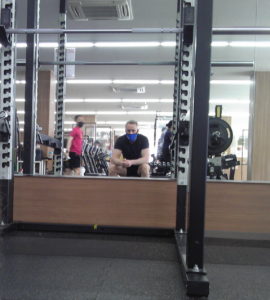Ask anyone whose time in the gym is measured in decades, and they’ll tell you that it’s not the muscles that go first, it’s the soft tissue: the joints and tendons, the spongy discs between your vertebrae, the ligaments holding all your tiny foot bones in their proper place, the cartilage between your ribs…
I’ve written quite a bit about nutrition for keeping your tendons and so on healthy (try the keyword “nutrition” for this website), methods for preventing tendon pain in the first place (foam rolling before a workout and stretching after are great places to start), and a year or two back I started adding some exercise programs that can help (like this post detailing the Hundreds program). Today I’d like to add to that last category, and talk about speed training using weights. Because speed work with weights can have a positive impact on your tendon health.
If you’ve ever tried powerlifting, you know the name Westside. It’s the most famous powerlifting gym in the Western hemisphere, if not the entire world. Louie Simmons and his crew have produced some of the most respected names in the sport, and the number of world champions coming out of the Westside gym in Columbus, Ohio is constantly going up.
They use a lot of advanced training techniques, but the basic Westside template uses something called conjugated periodization. What this means in layman’s terms is simple: you work a particular lift (not a bodypart, like the chest, but a major lift, like the bench press or squat) twice a week, once using very heavy weights and once using very light weights…but training the lift for speed on the light day.
Basically, what you do is take somewhere around 50% of your maximum and do eight sets of three reps, performing the reps as quickly as you can while still maintaining good form. So let’s say your maximum bench press is 120kgs. You would train your speed day using about 60kgs (maybe a little more or less, based on individual characteristics, but you want to use the most weight you can while still being able to pop the weight up very quickly). After a good warm-up, you take the bar and lower it to your chest, pause for a moment, then blast it up as quickly as possible (while still maintaining good form, of course). Like, so quickly that you would launch it from your hands if you weren’t holding on. Perform three reps like this, wait one minute, then repeat for your second set. Do eight sets and then go to assistance work, which would be exercises targeting the triceps, deltoids and so on–the smaller muscles that contribute to the lift. The assistance work should be done conventionally, two or three sets of six to eight reps or thereabouts.
Speed work, because it uses such light weights, is much easier on joints and tendons than conventional weight training. But unlike most light work, training for speed on one’s lifts can add significantly to your 1RM (maximum weight). Try it for a couple of months and see for yourself.


